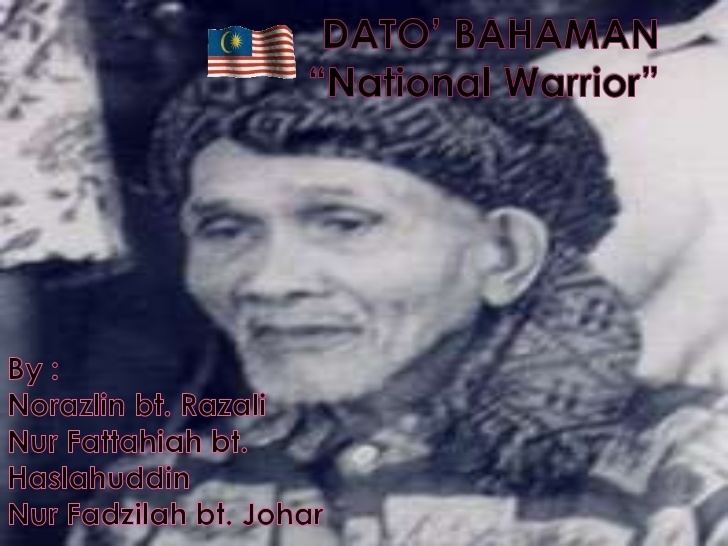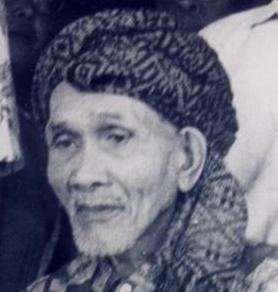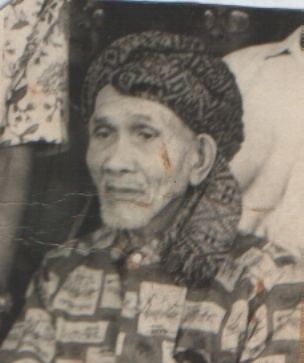 | ||
Died 1891, Terengganu, Malaysia Similar Dol Said, Haji Abdul Rahman Limbong, Tok Janggut | ||
Dato bahaman video sejarah 2 ab qowiy smkakl 2016
Abdul Rahman bin Tuanku Imam Nuh or also known as Dato' Bahaman (died 1930s in Terengganu) was a famous Malay warrior in Pahang, Malaysia during the period of British protectorate. His friend was the famous Silat warrior Tok Gajah the father of Mat Kilau. Dato' Bahaman was an Orang Besar Raja (a man who administrates the land given to him by the Sultan and a man of importance in the palace) in Pahang. He is the great-granduncle of Abu Samah Mohd Kassim, whom was also a famous fighter later became a central committee member of the Malayan Communist Party and nationalist in the Malayan National Liberation Army.
Contents
- Dato bahaman video sejarah 2 ab qowiy smkakl 2016
- Dato bahaman
- Origin
- AwardsPromotion
- Semantan War
- British Hunt
- Sworn of Loyalty
- References

Dato bahaman
Origin

Dato' Bahaman is the son of Tuanku Imam Nuh who came from Bangkinang, Kampar, Sumatera. Dato Bahaman was said to be adopted by Bendahara Ali and a playmate to Sultan Ahmad during his childhood. When Sultan Ahmad took the throne, Dato' Bahaman had sworn to give great service to his homeland.
Awards/Promotion

Dato' Bahaman was promoted as one of the Orang Besar Berlapan and was awarded the title name Dato' Setia Perkasa Pahlawan Semantan for showing his ability as an admiral in the civil war between Sultan Ahmad and the prince Wan Muhathir. He was also awarded for leading a squadron in helping Tengku Kudin in the civil war in Klang, Selangor. After the death of the Orang Kaya Indera Segera, Dato' Bahaman was promoted as the Orang Kaya Temerloh by Sultan Ahmad. With the rank given to him by the Sultan, Dato' Bahaman was ranked equally as the Orang Besar Berempat and was always summoned to the palace to give advice to the Sultan Ahmad.
Semantan War
The cause of the Semantan War was because of the suspicion and dissatisfaction of the Orang Besar Pahang and the Orang Kaya Semantan towards the British interference on their territories . The tension soon rose in December 1890 when a E.A Wise, a British officer, illegally set up a police station without negotiating at Lubuk Terua which was on the territory of Dato' Bahaman. When Hugh Clifford; manager of the British officers in Pahang found out the situation, he advice the Sultan to locate Dato' Bahaman in another area while the British officers investigate. The Sultan immediately, ordered Dato' Bahaman to move to the countryside nearby Kuantan. However, Dato' Bahaman refused and the Sultan sent a letter and disposed his rank of the Orang Kaya Semantan.
The action of the Sultan angered Dato' Bahaman . This caused him and his followers ambush C.E.M Deaborough at the Semantan River on 15 December 1891. When Dato' Bahaman expected an arrest from Deaborough after the ambush, it turned out that Deaborough's forces had lost and escaped to the city of Temerloh As soon as the British forces in the Peninsular Malaya heard news of their loss in Semantan, the British officers of Pahang rallied their forces to fight against the Malay rebellion. Following of the aftermath, on 21 December 1891, a squadron led by Hugh Clifford and Tengku Mahmud attacked Kampung Kelubi which was the second stronghold of Dato' Bahaman. Here another battle happened between the British forces and Dato' Bahaman. The resulting battle was a lost for the British but a victory for Dato' Bahaman.
British Hunt
In January 1892, the British officers forced Sultan Wan Ahmad to end the uprising of Dato' Bahaman in Pahang. A team was formed and given the name "Gerakan Sultan" or in English "Sultan's forces". The force was mobilized on 22 January 1892 with the strength of 800 men. It was estimated that 140 of the men carried fire arms and was led by Tengku Ali, Rodger (British officer), Admiral Garang Yusof, Admiral Saiyid Ali Badoh and Admiral Abdullah from Bera. These forces found failure besides just destroying 11 small fortresses including Batu Ampar Fortress. Dato' Bahaman was not found and there were no signs that he and his followers were nearby the area. On early February 1892, the rebellion had ended. The Semantan state was temporarily under the care of Abdullah Bera.
In March 1892, a squadron commanded by Dato' Bahaman successfully recaptured Lubuk Terua. The resistance of Dato' Bahaman became stronger after being helped by his friend, Tok Gajah. The British forces once more lost, outnumbered and with Abdullah Bera's order, they retreated to Bera. The Fortress of Lubuk Terua was well guarded by Malay soldiers from Cempaka and Buluh. The fortress was repeatedly attacked by the British forces.
In May 1892, an English squadron attacked the Fortress of Lubuk Terua again and successfully captured the fort.The Pahang warriors had no choice but to retreat and rally their forces once more in the state of Kelantan and Terengganu. In Terengganu, an ulama named Tok Ku Paluh convinced the Pahang warriors to fight for their homeland and free Pahang from British rule. In June 1894, Kuala Tembeling and Jeram Ampai was successfully conquered by Dato' Bahaman and one hundred Semantan warriors.
In June 1894 a British squadron led by General Walker ambushed a group of Semantan warriors led by Dato' Bahaman, Tok Gajah, Mat Kilau and Mat Kelubi at Jeram Ampai, Kuala Tembeling, Pahang. During the ambush an Administrator of Ulu Pahang named Wise, was killed together with four police officers. The Attack caused Mat Kilau, the son of Dato' Bahaman to retreat to the state of Kelantan. This was followed by the end of the war against the British in Pahang.
Sir Hugh Clifford, British officer in Pahang launched a mass attack on the remaining Semantan forces in Terengganu and Kelantan that swallowed large amounts of funds.
The Semantan forces ended on November 1895 when Dato' Bahaman, Pawang Nong and Mat Lela surrendered themselves to the Siamese government but given protection and were placed at Chiengmai early 1896. Tok Gajah and Mat Kilau were presumed dead by the British during the battle in Terrenganu.
The rise of Dato' Bahaman lasted for four to three years (1891–1894) had caused the British forces in Peninsular Malaysia lost large amount of money from the treasury. Sultan Ahmad had to pay 720 000 a year to solve the debt.
Sworn of Loyalty
Since that it is no longer safe in Pahang, Kelantan and Terengganu, Dato' Bahaman and his followers decided to retreat to Siam. Before that, an oath was made at Kg. Bukit Haji Pak Jedih, Tanah Merah, where the Semantan warriors swore to hide their identity and to not reveal themselves. Seven of them were involved during the oath. Dato Bahaman changed his name to Panglima Kakap, Mat Kilau changed his name to Mat Siam. However he was almost caught by British officers and often changed his name such as Mat Dadu, Mat Dahan or Mohammed Ibrahim. Mat Lela too changed his name, into Kilat Senja or Gong Poh. Mat Kelubi changed his name to Tok Janggut.
In the year of 1911, Dato' Bahaman returned to Kelantan while Mat Lela moved to Indonesia and it was rumored that Mat Lela joined the fight against Dutch occupation. The two remaining warriors died in Patani, Siam. In the year 1920, Dato' Bahaman returned to Kuantan, Pahang and lived in Kampung Paya Lalang (Padang Lalang) and changed his name as Lebai Deraman. In the year 1926, Dato' Bahaman moved to Kampung Peramu and was known as Tok Guru Peramu. Mat Kilau was said that he had often moved from place to another starting from Kampung Aur Rompin, to Tanjung Medang, Kampung Pasir Panjang, Kampung Batu Tering Pekan, Kampung Batu Lima Jalan Gambang. Mat Kelubi and Admiral Hitam's story was unknown. Dato' Bahaman lived in Kampung Peramu until his death.
